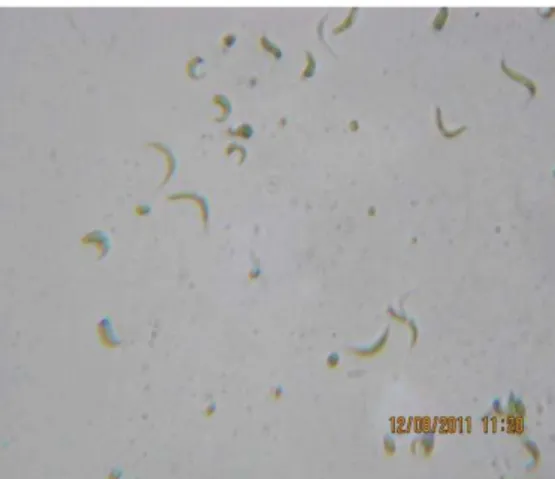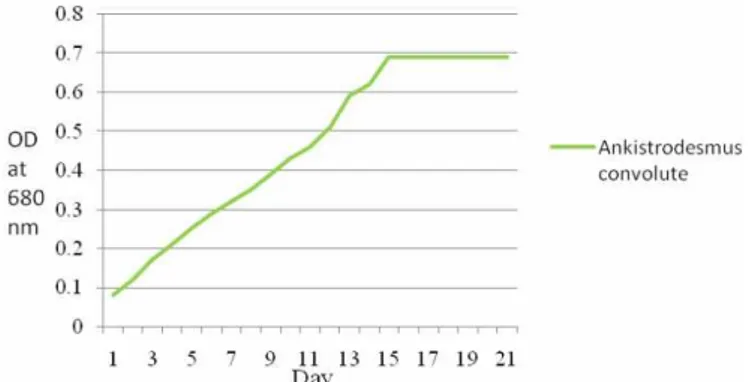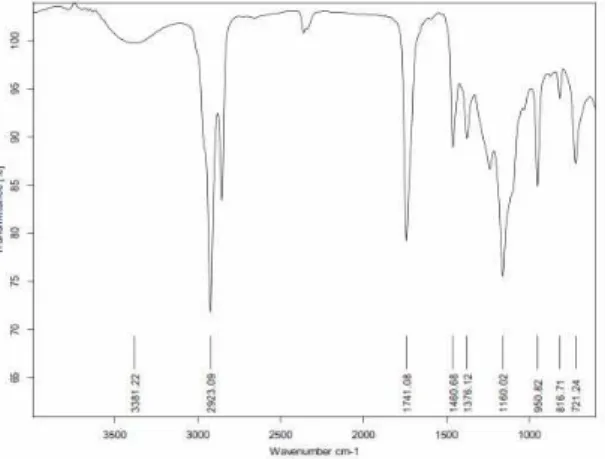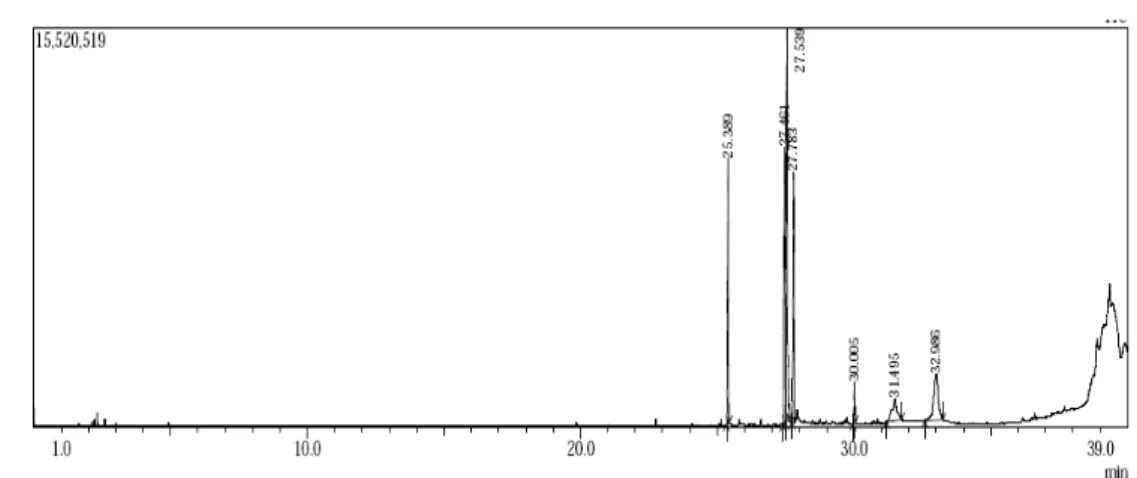Chlorococcalean microalgae
Ankistrodesmu
s convolutes biodiesel
characterization with Fourier transform-infrared spectroscopy and gas
chromatography mass spectroscopy techniques
Swati SONAWANE1,*, Sanjaykumar DALVI2, and Raghunath POKHARKAR1
1
Department of Chemistry, S. N. Arts, D. J. M. Commerce & B. N. S. Science College, Sangamner, Dist Ahmednagar, (M.S.) 422605, India
2
Savitribai Phule Pune University, Ganeshkhind, Pune, (M.S.), 411007, India
E-mails: swatis2003@yahoo.co.in; snd_rang@yahoo.co.in ; raghunathpokharkar@rediffmail.com
*
Corresponding author, phone: +91- 9326710125
Abstract
The Chlorococcalean microalgae Ankistrodesmus convolutes was found in
fresh water Godawari reservoir, Ahmednagar district of Maharashtra State,
India. Microalgae are modern biomass for the production of liquid biofuel due
to its high solar cultivation efficiency. The collection, harvesting and drying
processes were play vital role in converting algal biomass into energy liquid
fuel. The oil extraction was the important step for the biodiesel synthesis. The
fatty acid methyl ester (FAME) synthesis was carried through base catalyzed
transesterification method. The product was analyzed by using the hyphened
techniques like Fourier Transform-Infrared spectroscopy (FT-IR) and Gas
Chromatography Mass Spectroscopy (GCMS). FT-IR Spectroscopy was
Introduction
An evaluating the potential renewable energy sources as alternative to fossil fuel is the
vital challenge for each developing country. The demand of liquid fuel energy is increases
continuously due to rapid industrialization and population. The basic non-renewable energy
sources are petroleum, coal, natural gas, hydro and nuclear [1]. The 45% of hydrocarbon
liquid fuel energy was obtained from fossil fuel based material which was the key economic
driver in India [2] but the fossil fuel was exhausted with alarming rates [3]. The emission of
air pollutants like NOx, SOx, CO, particulate matter and volatile organic compound after
combustion fossil fuel atmospheric pollution and contribute for the green house gas emission
(GHG) [4]. The high prices of hydrocarbon energy fuel with the dwindle feedstock of energy
move towards the renewable energy sources. Recently, the research work focused on the
modern clean energy feedstock like algae [5].
The aquatic alga biomass was represents the very interesting source of energy due to
its higher photosynthetic activity as compare to terrestrial plant [6]. The diverse group of
algae were comprises as macro and micro alga. It can be produce 1000-4000 gallon/ acre/yr
oil and cultivated in large open pond or in closed photo bioreactors located on non-arable
land. The microalgae produced high concentration of valuable compounds such as lipid,
protein and pigment [7-9]. The growth of microalgae and lipid productivity is depending on
growth medium composition, physical parameters and type of metabolism [10]. The rate of
water consumption during the cultivation of microalgae is low and it possessing short
harvesting cycle than the conventional crop cycle, hence it is better advantage to carry out the
algal biomass as biofuel [11-13].
The aim of this research work is to study the isolation and identification of microalgae
species from fresh water reservoir, medium selection and culture cultivation, algae growth
study, base catalyzed transesterification reaction for FAME synthesis, FT-IR Spectroscopy
and Gas Chromatography Mass Spectroscopy analysis of components of biodiesel product.
Material and method
The microalgae were collected by plankton net (20 µm pore size) from fresh water
Godawari reservoir, Ahmednagar (Maharashtra), India. The microalgae sample was collected
in clean plastic container from sampling location. The sample was immediately brought for
algal studies. The water sample was observed on the spot in natural condition. The
morphology of pure strains was regularly examined under an optical microscope and
identified with the help of standard literature (Figure 1).
Figure 1. Ankistrodesmus convolutes microalgae
The Bold basal media used for culturing of Ankistrodesmusconvolutes (Figure 1). The
content of the media was NaNO3 (0.75), K2HPO4. 3 H2O (0.075), K H2PO4 (0.175), CaCl2
.H2O (0.025), MgSO4.7H2O (0.075), NaCl (0.025), EDTA (0.0000045), FeCl3.6 H2O
(0.000582), MnCl2.4 H2O (0.000246), ZnCl2.6 H2O (0.00003), CoCl2.6 H2O (0.000012),
Na2Mo2 H2O (0.000024). 10 ml of water samples were transferred to a 500 ml conical flask
containing 200 ml of sterilized BBM and then incubated on a rotary shaker at 27°C and 150
rpm under continuous illumination using white fluorescent light at intensities of 40 µmol /m2/
s. Every two days, the flasks were examined for algal growth using an optical microscope
Ankistrodesmus convolute strain in BBM media was study by determining the optical density
of samples at 680 nm using a UV-Spectrophotometer. The microalgae cells were harvested in
the stationary phase by centrifugation at 5000 rpm for 5 min and the cells were washed twice
using distilled water. The cell pellets were dried at 60˚C for 2 days and placed in desiccators
until constant weight. Dry weight of cells was obtained using an analytical balance. The lipid
content of microalgae was extracted by using the Bligh and Dyer method [14]. After cell
drying, algal powder was mix with chloroform–methanol (1:2) solvent for 30 min. Algal solid
was removed by centrifugation at 5000 rpm for 5 min. The residual solid and lipid separated
by solvent extraction procedure.
The Chemical conversion of algal oil to fatty acid methyl ester by alkali catalyzed
transesterification method which involves multiple steps of reaction between triglyceride or
fatty acid and alcohol. The methanol was used frequently for the commercial development
due to its low cost and its physical and chemical advantages [15] [16]. The base catalyzed
reaction was performed by using potassium methoxide with excess of methanol [17] [18]. The
reaction is carried in a round bottom flask. The microalgae oil mixed with methanol then
potassium hydroxide in methanol added. The reaction mixture was continuously stirring. The
reaction carried out at 60°C for 60 minutes. At room temperature, biodiesel product phase was
wash with distilled water to remove glycerol content and water soluble impurities by giving
2-3 time water wash to product with heating 85°C. It was preserved in airtight container and
used for further analysis (Figure 2). The fatty acid methyl esters were analyzed by standard
Figure 2. Process for Biodiesel production from microalgae
Results and discussion
The isolated microalgae strain belonging from Green algae, the division of
Chlorophyta, class of Chlorophycae, family of Chlorococcaceae, order of Chlorococcales,
genus Ankistrodesmus and species convolutes. Under the optical microscope Ankistrodesmus
The dry biomass of microalgae was found 0.047gl-1d-1 and lipid content 0.018 gl-1d-1 was
obtained. The 38.29% lipid content was achieved.
Figure 3.Growth curve ofAnkistrodesmus convolutes at the Optical density 680 nm
Figure 4. Biomass and lipid productivity (g/l/d) of Ankistrodesmus convolutes
The Chemical conversion of algal oil to fatty acid methyl ester by base catalyzed
transesterification method. The reaction is carried out at 60°C for 60 minutes. At room
temperature, biodiesel product phase was separated and purified.
The Fourier Transform-Infrared Spectroscopy is the standard method to study the
functional group of both reactant and product obtained. The IR Spectrum Ankistrodesmus
convolutes oil and biodiesel was shows in Figure 5 and 6. The IR spectrum algae oil (Figure
5) shows the υ (O-H) stretching of hydroxyl group of fatty acids at 3381.22 cm-1, υ as (sp3
C-H) stretching of hydrocarbon at 2923.09 cm-1, υ (C=O) stretching of carbonyl group from
fatty acids at 1741.08 cm-1, methylene (CH2) groups have a characteristic bending absorption
at 1460.68 cm-1. The methyl δs (CH3) group have characteristic bending absorption is 1376.12
cm-1, the υ (C-O) stretching of alkyl carbon and oxygen from fatty acids are at 1160.02 cm-1
and δr (CH2) bending (rocking) motion associated with four or more methylene (CH2) groups
in an open chain of fatty acid occurs at about 721.24 cm-1 while the IR Spectrum
group of fatty acid methyl ester at 2922.75 cm-1, υ (C=O) stretching of ester at 1743.21 cm-1,
δs(CH2) bending of methylene group at 1457.85 cm-1, δs(CH3) bending of methyl group absorption frequency at 1366.21 cm-1, υ(C-O) stretching of alkyl carbon and oxygen from
fatty acid methyl ester at 1163.15 cm-1, δr (CH2) bending of methylene group was observed at
721.34 cm-1.
The FT-IR analysis is carried out both Ankistrodesmus convolutes algal oil and
biodiesel, the hydroxyl group (–OH) of fatty acid is disappear which not observed in IR
spectrum of algal biodiesel, the appearance of peak in algal oil and its biodiesel was different.
Figure 5. FT-IR spectrum of Ankistrodesmus convolutes oil
Figure 6. FT-IR spectrum ofAnkistrodesmus convolutesbiodiesel
Figure 7. The qualitative peaks of Gas Chromatography spectrum of Ankistrodesmus convolutes microalgae Biodiesel
Table.1. Ankistrodesmusconvolutes biodiesel components with RT, Percentage Area, Name of the Compound (FAME) and Molecular Formula
Sr. No.
Retention Time (min.)
Area
% Name of the Compound
Molecular Formula 1 25.389 15.36 Hexadecanoic acid, methyl ester C17H34O2 2 27.461 18.59 9,12-Octadecadienoic acid (Z, Z) methyl
ester C19H34O2 3 27.539 30.55 9-Octadecenoic acid methyl ester C19H36O2 4 27.783 14.11 Octadecanoic acid, methyl ester C19H38O2 5 30.005 2.05 Methyl 18-methylnonadecanoate C21H42O2 6 32.986 12.93 Methyl 20-methyl-heneicosanoate C23H46O2
The Figure 7 shows the qualitative peaks of Gas Chromatography spectrum of
Ankistrodesmus convolutes microalgae Biodiesel. Component of product was separated
according to mass to charge ratio. Table 1 show the six types of fatty acid methyl ester
components of Ankistrodesmus convolute biodiesel. The chromatogram shows peaks at
different retention time with different concentration. The experimental test results and the
ester were confirmed with MS library. At the retention time 25.389 min., Hexadecanoic acid,
methyl ester (15.36%); at 27.461 min., 9, 12-Octadecadienoic acid (Z,Z) methyl ester (18.59);
at 27.539 min., 9-Octadecenoic acid methyl ester (30.55%); at 27.783 min., Octadecanoic
acid, methyl ester (14.11%); at 30.005 min., Methyl 18-methylnonadecanoate (2.05%) and at
32.986min., Methyl 20-methyl-heneicosanoate (12.93%) were obtained. The FAME at the
retention time 25.389, 27.783, 30.005 and 32.986 shows the base peak at m/z 74.05 while at
27.461 and 27.539 shows the base peak at m/z 81 and 65 respectively. The GCMS data shows
that 9-Octadecenoic acid methyl ester possesses highest FAME percentage which was next to
ester. Ankistrodesmusconvolutes microalgae Biodiesel was consist of 46.5% saturated FAME
and 49.14 % unsaturated FAME.
Conclusions
The microalgae Ankistrodesmus convolutes was green algae belonging from the
division Chlorophyta. BBM was used for the growth study of microalgae species. The
productivity of biomass was 0.047gl-1d-1 and lipid 0.018 gl-1d-1 was obtained. The chemical
conversion of microalgae oil to biodiesel by base catalysed transesterification at 60°C for 60
minutes gave rise to 95.64% of biodiesel friction. The analysis of obtained product was
performed by FT-IR and GCMS techniques. The FT-IR shows characteristic ester functional
group frequency was appeared at 1743.21 cm-1. The GCMS results the mixture of six type of
fatty acid methyl ester. Ankistrodesmus convolutes microalgae biodiesel was the mixture of
46.5% saturated and 49.14 % unsaturated fatty acid methyl ester. The identified fatty acid
methyl ester was ranging from C17 to C23. According to Chisti (2007), the saturated and
unsaturated fatty acid methyl ester possesses high oxidative stability.
The utilization of microalgae renewable biomass energy in large extent to provides
sustainable development of nation which link to global stability, economic balance,
innovation in local market, employment and quality of life. Thus, Ankistrodesmus convolutes
could be considered as a potential algae for biodiesel production.
References
1. Kulkarni M. G., Dalai A. K., Waste cooking oil-an economical source for biodiesel: A
review, Ind. Eng. Chem. Res., 2006, 45, p. 2901-2913.
2. Ministry of Petroleum and Natural Gas, Report of the Working Groups on Petroleum and
5. Ramachandra T. V., Mahapatra D. M., Karthick B., Gordon R., Milking diatoms for sustainable energy; biochemical engineering vs gasoline secreting diatoms solar panels,
Ind. Eng. Chem. Res., 2009, 48, p. 8769-8788.
6. Shay E. G., Diesel fuel from vegetable oils: Status and Opportunities. Biomass Bioenergy,
1993, 4, p. 227-242.
7. Abe K., Nishumura N., Hirano M., Simultaneous production of β-carotene, vitamin E and
vitamin C by the aerial microalga Trentepohia aurea., J. Appl. Phycol., 1999, 11, p.
33-36.
8. El-Baz F. K., Aboul-Enein M. A., El-Baroty, G. S. Youssef, A. M., Abd El-Baky H. H.,
Accumulation of antioxidant vitamins in Dunaliella sallina, Online J. Biol. Sci., 2002, 2, p.
220-223.
9. Abd El-Barky H. H., Moawd A. El-behairy A. N., El-Baroty G. S., Chemoprevention of
benzo[a]pyrene induced carcinogen and lipid peroxidation in mice by lipophilic algae
extract (phycotene), J. Med. Sci., 2002, 2, p. 185-193.
10. Phukan M. M., Chutia R. S., Konwar B. K., Kataki R., Microalgae Chlorella as a potential bio-energy feedstock. Appl. Energy, 2011, 88, p. 3307-3312.
11. Chisti Y., Biodiesel from microalgae, 2007, Biotechnol Adv., 2007, 25, p. 294-306.
12.Singh R., Behera S., Yadav Y. K., Kumar S., Potential of wheat straw for biogas
production using thermophiles, in Recent Advances in Bio-Energy Research, Eds S.
Kumar, A. K. Sarma, S. K. Tyagi, and Y. K. Yadav (Kapurthala: SSS-National Institute of
Renewable Energy), 2014, p. 242-249.
13.Demirbas A., Use of algae as biofuel sources. Energy Convers. Manag., 2010, 50, p. 14-34. 14. Bligh E. G., Dyer W. J., A rapid method of total lipid extraction and purification. Can J
Biochem Physiol Pharmacol., 1959, 37, p. 911-917.
15. Bisen P. S., Sanodiya B. S., Thakur G. S., Baghel R. K., Prasad B. K. S., Biodiesel production with special emphasis on lipase-catalysed transesterification. Biotechnol.
Lett., 2010, 32, p. 1019-1030.
16.Surendhiran D., Vijay, M., Microalgal biodiesel-acomprehensive review on the potential
and alternative biofuel, Res. J. Chem. Sci., 2012, 2, p. 71-82.
17.Dalvi S. N., Sonawane S. R., and Pokharkar R. D., Preparation of Biodiesel of Undi seed
with In-situ Transesterification. Leonardo Electronic Journal of Practices and
Technologies., 2012, 20, p. 175-182.




